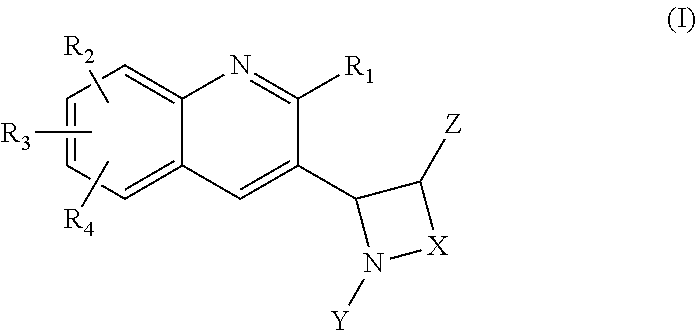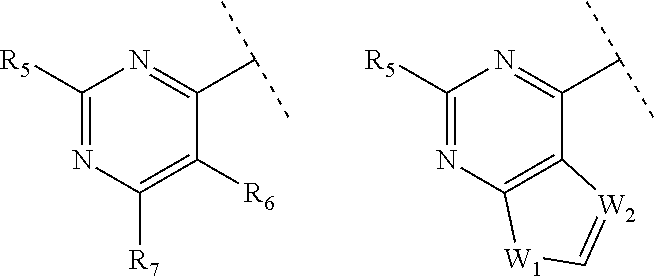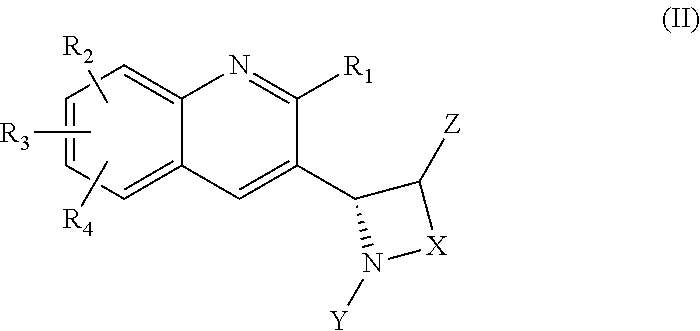Heterocyclic compounds as inhibitors of class I PI3KS
a technology of phosphatidylinositol 3ks and heterocyclic compounds, which is applied in the field of new selective inhibitors of class i pi3ks, can solve the problems of limited single-agent activity of inhibitors targeting pi3k, akt or mtor at tolerated doses, and achieves the effects of reducing symptoms, reducing symptoms, and improving drug safety
- Summary
- Abstract
- Description
- Claims
- Application Information
AI Technical Summary
Benefits of technology
Problems solved by technology
Method used
Image
Examples
example 1
Synthesis of 3-(1-(9H-purin-6-yl)pyrrolidin-2-yl)-7-fluoro-2-(pyridin-3-yl)quinoline (1)
[0064]Compound 1 was prepared according to the procedures set forth in steps 1-6 of Scheme 1 below:
Step 1: 1-(2-chloro-7-fluoroquinolin-3-yl)but-3-en-1-ol (2)
[0065]To a solution of 2-chloro-7-fluoroquinoline-3-carbaldehyde (2.0 g, 9.5 mmol; CAS #: 745830-16-4) in THF (191 mL) was added zinc dust (3.1 g, 47.7 mmol) and allyl bromide (1.6 mL, 19.1 mmol), followed by dropwise addition of saturated aqueous ammonium chloride solution (95.4 mL). The reaction mixture was stirred at room temperature for 4 h and filtered via Celite. The filtrate was acidified with 2N HCl (150 mL) and extracted with ethyl acetate (150 mL×1, 100 mL×2). The combined organic extracts was washed with brine (100 mL), dried (MgSO4), and concentrated. Purification by silica-gel column chromatography (25% EtOAc / hexane) yielded the title product (1.7 g, 71%) as a yellow oil.
[0066]1H NMR (300 MHz, CDCl3) δ 2.41 (m, 2H), 2.84 (m, 1H)...
example 2
Synthesis of 4-amino-6-(2-(7-fluoro-2-morpholinoquinolin-3-yl)pyrrolidin-1-yl)pyrimidine-5-carbonitrile (7)
[0075]Compound 7 was prepared according to the procedures set forth in steps 1-3 of Scheme 2 below:
Step 1: tert-butyl 2-(7-fluoro-2-morpholinoquinolin-3-yl)pyrrolidine-1-carboxylate (8)
[0076]Intermediate 5 (70 mg, 0.20 mmol) was treated with morpholine (1.0 mL) at 100° C. overnight in a sealed tube. The reaction mixture was cooled to room temperature and evaporated to dryness. Purification by silica-gel chromatography (25% EtOAc / hexane) afforded Compound 8 (75 mg, 93%) as a white solid. MS (ESI): m / z 402.2 (M+H)+.
Step 2: 4-(7-fluoro-3-(pyrrolidin-2-yl)quinolin-2-yl)morpholine (9)
[0077]To a solution of tert-butyl 2-(7-fluoro-2-morpholinoquinolin-3-yl)pyrrolidine-1-carboxylate (75 mg, 0.19 mmol) in CH2Cl2 (2 mL) was added TFA (2 mL). The reaction mixture was stirred at room temperature under argon for 1 h. Evaporation and co-evaporation with CHCl3 twice to dryness gave 4-(7-fluor...
example 3
Synthesis of 3-(1-(9H-purin-6-yl)pyrrolidin-2-yl)-7-fluoro-2-(pyridin-2-yl)quinoline (10)
[0079]Compound 10 was prepared according to the procedures set forth in steps 1-3 of Scheme 3 below:
Step 1: tert-butyl 2-(7-fluoro-2-(pyridin-2-yl)quinolin-3-yl)pyrrolidine-1-carboxylate (11)
[0080]A mixture of compound 5 (120 mg, 0.35 mmol), 2-(tributylstannyl)pyridine (157 mg, 0.426 mmol), and Pd(PPh3)4 (40 mg, 0.035 mmol) in dioxane (3 mL) was purged with argon for 1 min and then stirred at 120° C. over 21 hours in a sealed tube. The reaction mixture was cooled to room temperature, and evaporated to dryness. Purification by silica gel chromatography using EtOAc / CH2Cl2 (5% to 20%) afforded the title compound (41 mg, 30%) as a colorless oily residue. 1H NMR (300 MHz, DMSO-d6) δ 0.91, 1.37 (s, 9H), 1.7-2.0 (br m, 4H), 3.71, 3.50 (br m, 2H), 5.24, 5.58 (br m, 1H), 7.56 (m, 2H), 7.80 (dd, J=10.5 Hz and 2.4 Hz, 1H), 8.0 (m, 2H), 8.19, 8.35 (s and t, 2H), 8.72 (d, J=4.5 Hz, 1H); MS (ESI): m / z 394.2 (...
PUM
| Property | Measurement | Unit |
|---|---|---|
| flow rate | aaaaa | aaaaa |
| temperature | aaaaa | aaaaa |
| temperature | aaaaa | aaaaa |
Abstract
Description
Claims
Application Information
 Login to View More
Login to View More - R&D
- Intellectual Property
- Life Sciences
- Materials
- Tech Scout
- Unparalleled Data Quality
- Higher Quality Content
- 60% Fewer Hallucinations
Browse by: Latest US Patents, China's latest patents, Technical Efficacy Thesaurus, Application Domain, Technology Topic, Popular Technical Reports.
© 2025 PatSnap. All rights reserved.Legal|Privacy policy|Modern Slavery Act Transparency Statement|Sitemap|About US| Contact US: help@patsnap.com



